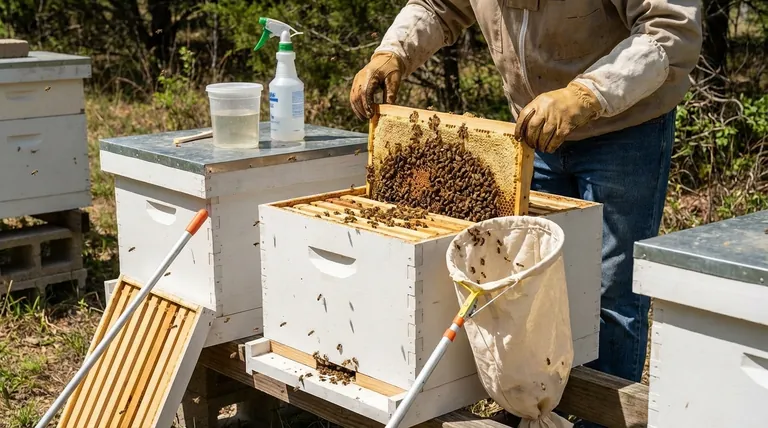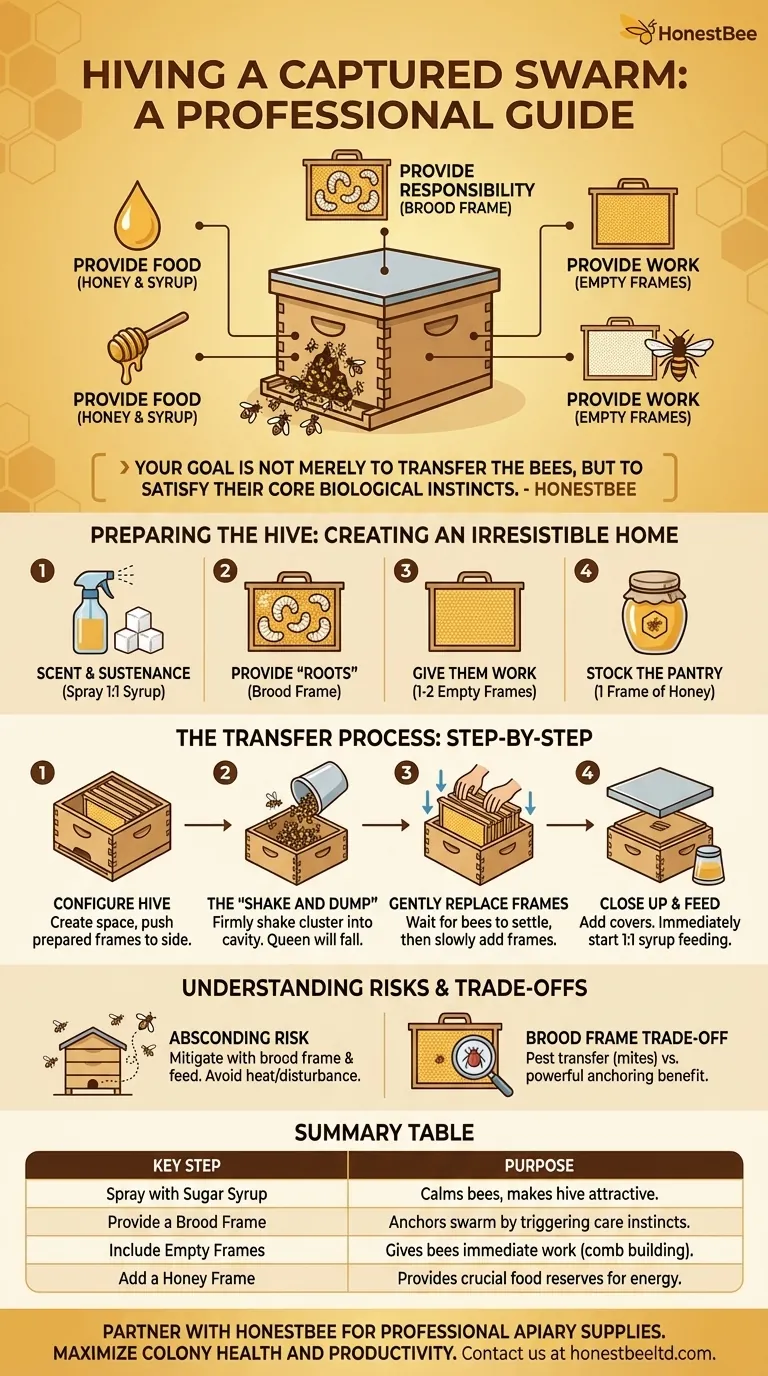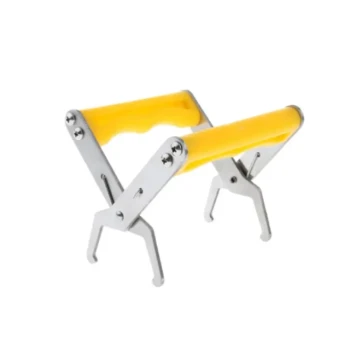Successfully hiving a captured swarm is a straightforward process centered on convincing the bees that their new box is an ideal home. To do this, you will remove several frames from a hive body to create an open space, spray the interior with sugar syrup, and then firmly but gently shake the bees from their capture container into the hive. The key is to provide them with the right combination of food, space, and a compelling reason to stay.
Your goal is not merely to transfer the bees, but to satisfy their core biological instincts. By providing food (honey and syrup), work (empty frames to build on), and responsibility (a frame of brood to care for), you anchor the swarm and drastically reduce the chances they will leave.

Preparing the Hive: Creating an Irresistible Home
Before you move the bees, you must first stage their new home. This preparation is the most critical factor in convincing a swarm to accept the hive and not abscond.
The Importance of Scent and Sustenance
Spraying the inside of the hive body and the tops of the frames with a 1:1 sugar syrup serves two purposes.
First, it provides an immediate source of food, calming the bees and giving them energy. Second, the sweet scent makes the new, unfamiliar wooden box a much more attractive environment.
Providing "Roots" with a Brood Frame
A swarm's instinct is to find a location and immediately start raising the next generation. Giving them a frame with existing brood (unsealed larvae) from another healthy hive is the single most effective way to anchor them.
When the bees sense there are young that need to be fed and cared for, their instinct to stay and protect them is powerfully triggered. This frame acts as "roots," telling the swarm they are already established.
Giving Them Work to Do
A swarm is a workforce primed for construction. Their bodies are optimized to produce wax and build comb.
Including one or two empty frames with foundation (or even just empty space) gives them an immediate and necessary task. This channels their immense energy into building their new home, rather than thinking about leaving it.
Stocking the Pantry
Include one frame that contains honey. A captured swarm has expended significant energy and has limited food reserves.
Providing a frame of honey gives them a crucial nutritional buffer, ensuring they have the resources to begin comb production and support the queen as she starts to lay eggs, especially if outside foraging conditions are poor.
The Transfer Process: Step-by-Step
With the hive prepared, the physical transfer is a quick and decisive event.
Step 1: Configure the Hive Body
Set up your hive box on its permanent stand. Remove 3-4 frames from the center to create a large, open cavity. Your prepared frames (one brood, one honey, one or two empty) should be pushed to one side.
Step 2: The "Shake and Dump"
Position your swarm-capture container (bucket, box, or nuc) over the open hive body. In one firm, confident motion, shake the entire cluster of bees down into the hive.
Most of the bees, including the queen, will fall into the cavity. Don't worry if some bees take flight; they will soon smell their queen and sisters and begin fanning at the entrance to guide the others in.
Step 3: Gently Replace Frames
Give the bees a few minutes to settle down from the sides of the hive into the bottom.
Then, slowly and carefully, begin adding the remaining frames back into the hive. Be mindful to avoid crushing bees, gently pushing them down and out of the way with the edge of the frame as you lower it.
Step 4: Close Up and Begin Feeding
Once all frames are in place, add your inner cover and the telescoping outer cover.
Immediately place a feeder on the hive filled with 1:1 sugar syrup. Consistent feeding for the first one to two weeks is essential for stimulating wax production and rapid colony build-up.
Understanding the Trade-offs and Risks
While the process is reliable, it's important to be aware of the associated risks and limitations.
The Primary Risk: Absconding
Absconding is when a colony completely abandons a hive. A new swarm is most likely to do this in the first 24-48 hours if they deem the location unsuitable.
Following the steps above—especially providing a brood frame and feed—makes absconding very unlikely. However, factors like an overheated location, ant infestations, or excessive disturbance can still trigger it.
The Downside of Using a Brood Frame
When you take a frame of brood from a donor hive, you also transfer its pest profile. Most notably, you will be transferring varroa mites along with the bees.
This is a manageable and widely accepted trade-off. The benefit of anchoring the swarm almost always outweighs the risk of introducing a small number of mites, which can be treated later.
What if You Don't Have a Brood Frame?
If you are a new beekeeper and the swarm is your first colony, you won't have a brood frame to give. This increases the risk of the swarm absconding, but it does not make it inevitable.
In this scenario, feeding becomes absolutely critical. Providing drawn comb, if you can acquire it from another beekeeper, is the next best thing to a brood frame.
Making the Right Choice for Your Goal
Adapt your setup based on the resources you have available.
- If you have an established apiary: Always use a frame of open brood from a healthy hive; it is the most powerful tool for ensuring the swarm stays put.
- If this is your very first colony: Focus heavily on continuous feeding and use frames with new foundation; monitor the entrance for the first two days to ensure the bees are actively foraging and not preparing to leave.
- If the swarm seems small or the weather is poor: Prioritize giving them a frame of honey and consistent feed to ensure they have the energy reserves to survive and begin building.
By understanding and providing for the swarm's fundamental needs, you transform a homeless cluster of bees into a thriving, productive colony.
Summary Table:
| Key Preparation Step | Purpose |
|---|---|
| Spray with Sugar Syrup | Calms bees and makes the hive attractive. |
| Provide a Brood Frame | Anchors the swarm by triggering care instincts. |
| Include Empty Frames | Gives bees immediate work (comb building). |
| Add a Honey Frame | Provides crucial food reserves for energy. |
Ready to build a thriving apiary? Hiving a swarm is just the first step. Equip your operation with durable, professional-grade supplies from HONESTBEE. We supply commercial apiaries and beekeeping equipment distributors with the wholesale-focused tools needed for success. Let us help you maximize colony health and productivity. Contact our expert team today to discuss your needs!
Visual Guide

Related Products
- HONESTBEE Professional Telescopic Pole Bee Swarm Catcher
- Friendly Bee Mascot Costume Vibrant Engaging Promotional Asset
- 8 Frame and 10 Frame Propolis Trap Collector Screen for Propolis Collection
- Ergonomic High Visibility Plastic Frame Grip Handles
- HONESTBEE Professional Entrance Bee Feeder Hive Nutrition Solution
People Also Ask
- Do honey bees leave their hives? Understanding the Critical Role of Swarming
- What are the three main ways to obtain honeybees? Choose the Best Path for Your Apiary
- Where is the best place to put a bee trap? Intercept Scout Bees for Maximum Swarm Capture
- How do commercial beekeepers prevent swarming? Master Proactive Hive Management
- How can walk-away splits help in swarm prevention? A Proactive Strategy for Beekeepers



















